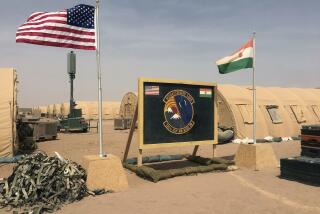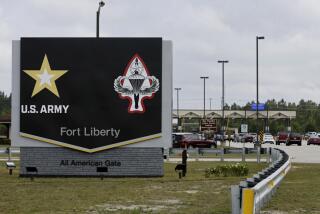After 89 Years, U.S. Lowers Flag at Clark Air Base
- Share via
CLARK AIR BASE, Philippines — As bugles blared retreat and a farewell honor guard stood at attention, the American flag was slowly lowered for the last time here Tuesday as the United States formally turned over its oldest and once-largest overseas base to the Philippines.
Within an hour of the solemn ceremony, dozens of looters were reported climbing over fences toward a base housing complex and ripping out major electric cables. Other military-issued items, from boxes of MRE field rations to kitchen sinks, already are on sale in nearby black market shops.
Clark’s closing, after 89 years as an American base, leaves about 5,500 U.S. personnel at the sprawling naval base and air station at Subic Bay, which services the 7th Fleet. Talks are under way in Manila to close that facility in 1994, a result of the Philippine Senate’s dramatic rejection in September of a proposed 10-year lease.
The final 245 Americans at Clark--all who remained of nearly 20,000 service personnel, civilian employees and dependents evacuated before the devastating eruption of neighboring Mt. Pinatubo last June--were to fly out of the Philippines by midafternoon. Their departure ends a historic role for a base long considered key to U.S. military operations from Asia to the Middle East.
“None of us will remain behind, and I know of no plans to replace us,” said Maj. Gen. William A. Studer, commander of the 13th Air Force, which is being moved to Andersen Air Force Base in Guam. “The longstanding U.S. presence here is ending.”
Moments later, Gen. Jimmy Adams, commander of the U.S. Air Force in the Pacific, handed a symbolic key to Clark to the Philippines’ armed forces chief, Gen. Lisandro Abadia. A four-man color guard folded the U.S. flag and presented it to U.S. Ambassador Frank Wisner.
“Where once we heard the roar of American aircraft, we will hear sounds of Filipinos building their lives, defending their homeland and contributing to this nation’s future,” Wisner told several hundred people gathered on the dusty parade ground under cloudy skies.
Clark was ordered shut after it suffered massive damage in the Pinatubo eruption. Officials said 111 buildings collapsed, 235 sustained serious damage and 318 others required extensive cleanup and mud removal. With ash still falling occasionally, gritty volcanic sand remains heaped along roads, covers rooftops and blankets the giant runways, making jet flight impossible.
Clark’s Military Airlift Command hub and about 50 troops have moved to the Cubi Point air station at Subic, where large transport planes continue to operate. The sophisticated Crow Valley combat pilot training range is being rebuilt in Alaska, and the 53rd Special Operations Wing has been temporarily redeployed on Okinawa.
Philippine officials still have not decided what to do with the 3,545 buildings and military structures on the huge base. The inventory includes 1,639 housing units, some newly built and never lived in, plus dormitories, restaurants, schools, stores, playgrounds, a golf course, cinemas, a large hospital and other facilities.
The government had hoped to turn the base into an international airport and manufacturing center, but the uncertain future of an active volcano nearby has put all plans on hold. Philippine Defense Secretary Renato de Villa said Clark ultimately will become “a model of an industrial, commercial and military complex.”
The United States also turned over to the Philippine air force about 116,000 removable items, including office and home furniture, appliances, hospital equipment, cars, trucks and tractors. Widespread looting on the base since June has moved toilets, fire hoses, prosthetic devices, light fixtures, air conditioners and other equipment into shops in the nearby town of Dau.
Shopkeeper Tony Soriano, standing by a dozen U.S. military-issue office chairs and desks, said he will miss the Americans. “I think maybe they will come back to Clark,” he said. “I hope so.”
Except for the looters, Clark’s closing is a severe blow for the volcano-ravaged economy of central Luzon. Officials in neighboring Angeles City said that at least 15,000 people had lost jobs on the base, and tens of thousands of others were affected by the loss of more than $100 million a year in local wages, goods and services. Bar owners in the seedy warren of honky-tonks and discos outside Clark’s main gate said fewer than 25 of 150 once-busy bars will remain open.
“You walk downtown at night and it’s like somebody died, which is really what it is,” said Bill Jones, a former U.S. airman who retired to Angeles City 15 years ago.
Clark played a historic role almost since its founding in 1903 as a U.S. cavalry garrison. It quickly grew to 156,204 acres, America’s largest overseas base. Japanese planes bombed it hours after they hit Pearl Harbor in December, 1941, and used its five runways until U.S. forces recaptured it late in the war. It was home base for kamikaze pilots flying suicide missions against American ships.
Later, Clark served as a transshipment hub during the Korean War, and it was a major command and logistics center during the Vietnam War. So many Americans were assigned here in that conflict that their children had to attend school in shifts.
While the American-controlled part of the base was reduced in 1979, the 46,000-acre Crow Vally range played a key training role for combat pilots during this year’s Persian Gulf War.
Among the military leaders who served here were Douglas MacArthur, his aide Dwight D. Eisenhower, Billy Mitchell and John J. Pershing. Others who passed through included American POWs released by North Vietnam in 1973, 1,565 orphans evacuated as Saigon fell and more than 30,000 Indochinese refugees on their way to America.
Former Philippine strongman Ferdinand E. Marcos and his family fled aboard a U.S. jet from Clark in 1986. Three years later, the Air Force scrambled F-4 Phantom jets over Manila to help put down a coup attempt against his successor, President Corazon Aquino.
Clark Air Base
HISTORY: Clark Air Base opened in 1902 and was once the largest U.S. overseas base. It was heavily damaged when nearby Mt. Pinatubo erupted.
DESCRIPTION: The 130,000-acre base had been home to about 20,000 American service personnel and military dependents. The 13th Air Force, headquartered at Clark, is being transferred to Guam.
FUTURE: The Philippine government may turn the base into an international airport and business center. But the proximity of the active volcano appears to have put those plans on hold.
More to Read
Sign up for Essential California
The most important California stories and recommendations in your inbox every morning.
You may occasionally receive promotional content from the Los Angeles Times.














